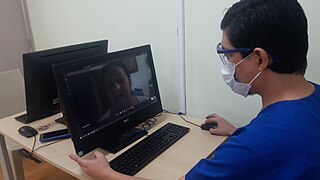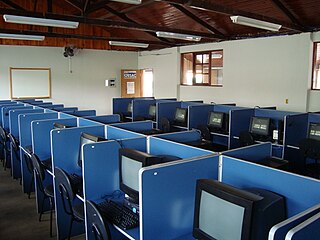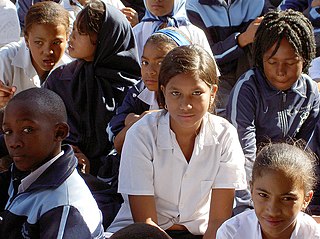Related Research Articles
Distance education, also known as distance learning, is the education of students who may not always be physically present at school, or where the learner and the teacher are separated in both time and distance. Traditionally, this usually involved correspondence courses wherein the student corresponded with the school via mail. Distance education is a technology-mediated modality and has evolved with the evolution of technologies such as video conferencing, TV, and the Internet. Today, it usually involves online education and the learning is usually mediated by some form of technology. A distance learning program can either be completely a remote learning, or a combination of both online learning and traditional offline classroom instruction. Other modalities include distance learning with complementary virtual environment or teaching in virtual environment (e-learning).

Remote work is the practice of working from one's home or another space rather than from an office.

Telehealth is the distribution of health-related services and information via electronic information and telecommunication technologies. It allows long-distance patient and clinician contact, care, advice, reminders, education, intervention, monitoring, and remote admissions. Telemedicine is sometimes used as a synonym, or is used in a more limited sense to describe remote clinical services, such as diagnosis and monitoring. When rural settings, lack of transport, a lack of mobility, conditions due to outbreaks, epidemics or pandemics, decreased funding, or a lack of staff restrict access to care, telehealth may bridge the gap as well as provide distance-learning; meetings, supervision, and presentations between practitioners; online information and health data management and healthcare system integration. Telehealth could include two clinicians discussing a case over video conference; a robotic surgery occurring through remote access; physical therapy done via digital monitoring instruments, live feed and application combinations; tests being forwarded between facilities for interpretation by a higher specialist; home monitoring through continuous sending of patient health data; client to practitioner online conference; or even videophone interpretation during a consult.

Asynchronous learning is a general term used to describe forms of education, instruction, and learning that do not occur in the same place or at the same time. It uses resources that facilitate information sharing outside the constraints of time and place among a network of people. In many instances, well-constructed asynchronous learning is based on constructivist theory, a student-centered approach that emphasizes the importance of peer-to-peer interactions. This approach combines self-study with asynchronous interactions to promote learning, and it can be used to facilitate learning in traditional on-campus education, distance education, and continuing education. This combined network of learners and the electronic network in which they communicate are referred to as an asynchronous learning network.
A learning management system (LMS) or virtual learning environment (VLE) is a software application for the administration, documentation, tracking, reporting, automation, and delivery of educational courses, training programs, materials or learning and development programs. The learning management system concept emerged directly from e-Learning. Learning management systems make up the largest segment of the learning system market. The first introduction of the LMS was in the late 1990s. LMSs have been adopted by almost all higher education institutions in the English-speaking world. Learning management systems have faced a massive growth in usage due to the emphasis on remote learning during the COVID-19 pandemic.

An online school teaches students entirely or primarily online or through the Internet. It has been defined as "education that uses one or more technologies to deliver instruction to students who are separated from the instructor and to support regular and substantive interaction between the students. Online education exists all around the world and is used for all levels of education. This type of learning enables the individuals to earn transferable credits, take recognized examinations, and advance to the next level of education over the Internet.
Educational technology is the combined use of computer hardware, software, and educational theory and practice to facilitate learning. When referred to with its abbreviation, "EdTech", it often refers to the industry of companies that create educational technology. In EdTech Inc.: Selling, Automating and Globalizing Higher Education in the Digital Age, Tanner Mirrlees and Shahid Alvi (2019) argue "EdTech is no exception to industry ownership and market rules" and "define the EdTech industries as all the privately owned companies currently involved in the financing, production and distribution of commercial hardware, software, cultural goods, services and platforms for the educational market with the goal of turning a profit. Many of these companies are US-based and rapidly expanding into educational markets across North America, and increasingly growing all over the world."
Technology integration is defined as the use of technology to enhance and support the educational environment. Technology integration in the classroom can also support classroom instruction by creating opportunities for students to complete assignments on the computer rather than with normal pencil and paper. In a larger sense, technology integration can also refer to the use of an integration platform and application programming interface (API) in the management of a school, to integrate disparate SaaS applications, databases, and programs used by an educational institution so that their data can be shared in real-time across all systems on campus, thus supporting students' education by improving data quality and access for faculty and staff.
"Curriculum integration with the use of technology involves the infusion of technology as a tool to enhance the learning in a content area or multidisciplinary setting... Effective technology integration is achieved when students can select technology tools to help them obtain information on time, analyze and synthesize it, and present it professionally to an authentic audience. Technology should become an integral part of how the classroom functions—as accessible as all other classroom tools. The focus in each lesson or unit is the curriculum outcome, not the technology."

Education in South Africa is governed by two national departments, namely the Department of Basic Education (DBE), which is responsible for primary and secondary schools, and the Department of Higher Education and Training (DHET), which is responsible for tertiary education and vocational training. Prior to 2009, both departments were represented in a single Department of Education. Among sub-Saharan African countries, South Africa has one of the highest literacy rates. According to The World Factbook - Central Intelligence Agency as of 2019, 95% of the population aged from 15 and over can read and write in South Africa were respectively literate.

Telepsychiatry or telemental health refers to the use of telecommunications technology to deliver psychiatric care remotely for people with mental health conditions. It is a branch of telemedicine.
Online tutoring is the process of tutoring in an online, virtual, or networked, environment, in which teachers and learners participate from separate physical locations. Aside from space, participants can also be separated by time.
Online communication between home and school is the use of digital telecommunication to convey information and ideas between teachers, students, parents, and school administrators. As the use of e-mail and the internet becomes even more widespread, these tools become more valuable and useful in education for the purposes of increasing learning for students, and facilitating conversations between students, parents, and schools.

Paper is an educational technology company that partners with school systems to offer access to academic support such as tutoring, coaching, college and career support, and practice in core curricula.

The COVID-19 pandemic affected educational systems across the world. The number of cases of COVID-19 started to rise in March 2020 and many educational institutions and universities underwent closure. Most countries decided to temporarily close educational institutions in order to reduce the spread of COVID-19. UNESCO estimates that at the height of the closures in April 2020, national educational shutdowns affected nearly 1.6 billion students in 200 countries: 94% of the student population and one-fifth of the global population. Closures are estimated to have lasted for an average of 41 weeks. They have had significant negative effects on student learning, which are predicted to have substantial long-term implications for both education and earnings. During the pandemic, education budgets and official aid program budgets for education have decreased.

A systematic review notes that children with COVID-19 have milder effects and better prognoses than adults. However, children are susceptible to "multisystem inflammatory syndrome in children" (MIS-C), a rare but life-threatening systemic illness involving persistent fever and extreme inflammation following exposure to the SARS-CoV-2 virus.
There was a resurgence of homeschooling during the COVID-19 pandemic to help students return to school. Innovative parents sought to create solutions to their individual dilemmas by organizing local groups. These variations of homeschooling include micro schools and educational family co-ops. The first usually involves hired professionals to teach a small group of kids. The second is a parent-organized co-operative where families take turns educating and minding their kids during the week. Both are largely available only to the well-off, as costs in time and money are high. 'Pandemic pod' is the fashionable term used to describe one of these arrangements where all group members agree to participate under well-defined and strictly enforced health rules.

Individuals with disabilities are more susceptible to contracting COVID-19 and have higher mortality rates compared to those without disabilities. This is particularly true for people with intellectual and developmental disabilities, those residing in care facilities, and women with disabilities. Individuals with disabilities face heightened risks of mental health issues related to the pandemic, such as increased feelings of loneliness and isolation. They were also more likely to face domestic violence and abuse during the pandemic. People with disabilities are more likely to experience unemployment as a result of the pandemic and may require changes to the types of accommodations they require for work. Children with disabilities experience complications in their educational programming. Remote learning poses a host of challenges for children with disabilities, including disruptions to physical and occupational therapies and access to assistive technologies.

Most governments decided to temporarily close educational institutions in an attempt to reduce the spread of COVID-19. As of 12 January 2021, approximately 825 million learners are affected due to school closures in response to the pandemic. According to UNICEF monitoring, 23 countries are implementing nationwide closures and 40 are implementing local closures, impacting about 47 percent of the world's student population. 112 countries' schools are open.

The COVID-19 pandemic has impacted migrants throughout the globe. Low-skilled migrants, refugees, and internally-displaced migrants are at a higher risk of contracting the virus. The pandemic has also aggravated the dangers of already-dangerous migration routes. Since the outbreak of COVID-19, international organizations have recorded a spike in human rights abuses suffered by migrants, especially in Africa, Latin America, and Asia. The restrictions on travel, imposed as a measure to contain the virus, have resulted in a rise in "stranded migrants," individuals who want to return to their home countries but cannot.

In 2020, school systems in the United States began to close down in March because of the spread of COVID-19. This was a historic event in the history of the United States schooling system because it forced schools to shut-down. At the very peak of school closures, COVID-19 affected 55.1 million students in 124,000 public and private U.S. schools. The effects of widespread school shut-downs were felt nationwide, and aggravated several social inequalities in gender, technology, educational achievement, and mental health.
References
- ↑ Berg, Gary (31 October 2009). Cases on Online Tutoring, Mentoring, and Educational Services: Practices and Applications. Hershey, New York: IGI Global. ISBN 9781605668772.
- ↑ Chi Ng, Kwok (March 2007). "Replacing Face-to-Face Tutorials by Synchronous Online Technologies: Challenges and pedagogical implications". The International Review of Research in Open and Distance Learning. 8 (1).
- ↑ "TechCrunch article, June 2014". 3 June 2014.
- ↑ "Article on TheNextWeb.com, June 2014". 24 June 2014.
- 1 2 3 Tawnell D. Hobbs, Lee Hawkins (5 June 2020). "Wall Street Journal". Wall Street Journal. Retrieved 2021-04-18.
- 1 2 3 4 Blagg, Kristin; Blom, Erica; Gallagher, Megan; Rainer, Macy (April 2020). Mapping Student Needs during COVID-19: An Assessment of Remote Learning Environments. Urban Institute.
- ↑ "JAMA Health Forum". 2020. doi: 10.1001/jamahealthforum.2020.0724 . PMID 36218518.
{{cite journal}}: Cite journal requires|journal=(help) - ↑ "Tennessee Tutoring Corps". 2020.
- ↑ "Pandemic Professors". Pandemic Professors. April 18, 2021. Retrieved April 18, 2021.
- 1 2 Knox, Dave (March 2021). "How Nerdy Is Revolutionizing Online Learning To Expand Minds... And Its Business". Forbes. Retrieved 2021-05-12.
- ↑ "Rates & Availability". The Reading Guru. Retrieved 2022-10-19.
- ↑ "2022 Tutoring Prices | How Much Does a Tutor Cost? // Tutors.com". Tutors.com. Retrieved 2022-10-19.
- ↑ "2021 Tutoring Prices | How Much Does a Tutor Cost? // Tutors.com". Tutors.com. Retrieved 2021-05-12.
- 1 2 Newberry, Laura (2020-10-13). "Parents are paying up to $100 an hour for tutors, driving up demand and worsening inequities". Los Angeles Times. Retrieved 2021-05-12.